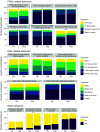The Effect of Individual or Study-Wide Report-Back on Knowledge, Concern, and Exposure-Reducing Behaviors Related to Endocrine-Disrupting Chemicals
- PMID: 37682721
- PMCID: PMC10489892
- DOI: 10.1289/EHP12565
The Effect of Individual or Study-Wide Report-Back on Knowledge, Concern, and Exposure-Reducing Behaviors Related to Endocrine-Disrupting Chemicals
Abstract
Background: To make informed decisions about endocrine-disrupting chemicals (EDCs), people need functional understanding of exposures and health and an ability to act on their knowledge. The return of biomonitoring results is an opportunity to educate people about EDCs and motivate exposure reduction.
Objectives: This study investigates environmental health knowledge about EDCs, concerns about health effects, and exposure-reducing behaviors before and after the return of individual-level exposure results or only study-wide results.
Methods: Women in the Child Health and Development Studies who were biomonitored for 42 EDCs were randomly assigned to receive a report with personal chemical results or only study-wide findings. We interviewed participants before and after report-back about their knowledge and concerns about EDCs and how frequently they performed exposure-related behaviors. We investigated baseline differences by education and race and examined changes after report-back by race and report type.
Results: Participants () demonstrated general understanding of exposure pathways and health impacts of EDCs. For 9 out of 20 knowledge questions, more than 90% of participants () gave correct responses at baseline, including for questions about chemicals' persistence in the body and effects of early-life exposure. Most participants held two misconceptions-about chemical safety testing in the United States and what doctors can infer from EDC results-although errors decreased after report-back. Initially, concern was higher for legacy pollutants, but report-back increased concern for consumer product chemicals. After report-back, participants took some actions to reduce exposures, particularly to per- and polyfluoroalkyl substances, and total behavior was associated with knowledge and concern but not race, education, or report type.
Discussion: This study demonstrated that participants had foundational knowledge about EDCs and that report-back further built their environmental health literacy. We conclude that future communications should target misconceptions about chemicals regulation in the United States, because information about regulations is crucial for people to evaluate risks posed by consumer product chemicals and decide whether to engage with public policy. https://doi.org/10.1289/EHP12565.
Figures

Comment in
-
Invited Perspective: Making the Implicit Explicit-Connecting Environmental Health Literacy and Exposure Report-Back.Environ Health Perspect. 2023 Sep;131(9):91301. doi: 10.1289/EHP13493. Epub 2023 Sep 8. Environ Health Perspect. 2023. PMID: 37682723 Free PMC article. No abstract available.
References
-
- Young AS, Herkert N, Stapleton HM, Coull BA, Hauser R, Zoeller T, et al. . 2023. Hormone receptor activities of complex mixtures of known and suspect chemicals in personal silicone wristband samplers worn in office buildings. Chemosphere 315:137705, PMID: , 10.1016/j.chemosphere.2022.137705. - DOI - PMC - PubMed
-
- Trasande L. 2019. Sicker, Fatter, Poorer: The Urgent Threat of Hormone-Disrupting Chemicals on Our Health and Future… and What We Can Do About It. Boston, MA: Houghton Mifflin Harcourt.
Publication types
MeSH terms
Substances
Grants and funding
LinkOut - more resources
Full Text Sources

